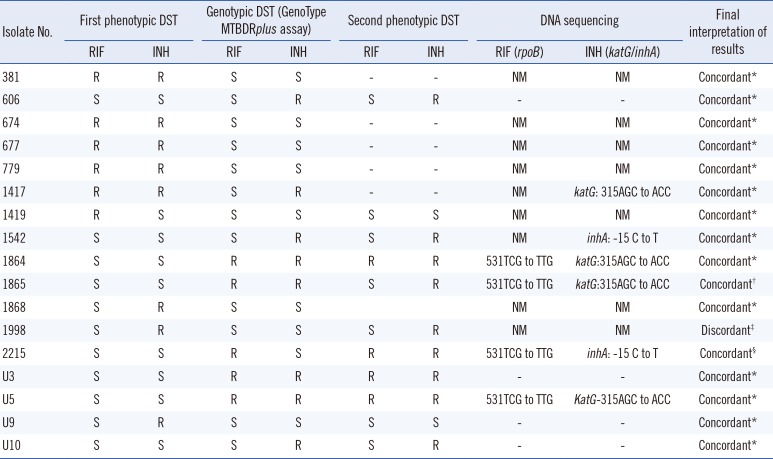1. World Health Organization. Global Tuberculosis Report 2012. WHO/HTM/TB/2012.6. Geneva: WHO;2012.
2. Agonafir M, Lemma E, Wolde-Meskel D, Goshu S, Santhanam A, Girmachew F, et al. Phenotypic and genotypic analysis of multidrug-resistant tuberculosis in Ethiopia. Int J Tuberc Lung Dis. 2010; 14:1259–1265. PMID:
20843416.
4. Hillemann D, Weizenegger M, Kubica T, Richter E, Niemann S. Use of the genotype MTBDR assay for rapid detection of rifampin and isoniazid resistance in
Mycobacterium tuberculosis complex isolates. J Clin Microbiol. 2005; 43:3699–3703. PMID:
16081898.
5. World Health Organization. Laboratory services in tuberculosis control. Culture Part III 1998; WHO/TB/98.258. Geneva: WHO;1998.
7. Viera AJ, Garrett JM. Understanding interobserver agreement: the kappa statistic. Fam Med. 2005; 37:360–363. PMID:
15883903.
8. World Health Organization. Management of MDR-TB: a field guide. WHO/HTM/TB/2008.402a. Geneva: WHO;2009.
9. Ti T, Lwin T, Phyu S, Aung WW, Khaing TMM, Min A, et al. Magnitude of the MDR-TB problem among patients attending Yangon Divisional TB Centre, Myanmar. Myanmar Med J. 2007; 50:2–7.
10. Phyu S, Ti T, Jureen R, Hmun T, Myint H, Htun A, et al. Drug-resistant Mycobacterium tuberculosis among new tuberculosis patients,Yangon, Myanmar. Emerg Infect Dis. 2003; 9:274–276. PMID:
12604008.
11. Ti T, Lwin T, Mar TT, Maung W, Noe P, Htun A, et al. National anti-tuberculosis drug resistance survey, 2002 in Myanmar. Int J Tuberc Lung Dis. 2006; 10:1111–1116. PMID:
17044203.
12. Aung WW, Ti T, Than KK, ThidaM , Nyein MM, Htun YY, et al. Study of drug resistant cases among new pulmonary tuberculosis patients attending a tuberculosis center, Yangon, Myanmar. Southeast Asian J Trop Med Public Health. 2007; 38:104–110. PMID:
17539254.
13. National Tuberculosis Programme, Myanmar. Annual Report 2012. Ministry of Health, Myanmar;NTP;2014. 10.
14. Bai GH, Park YK, Choi YW, Bai JI, Kim HJ, Chang CL, et al. Trends of anti-tuberculosis drug resistance in Korea, 1994-2004. Int J Tuberc Lung Dis. 2007; 11:571–576. PMID:
17439684.
15. Telenti A, Imboden F, Marchesi F, Lowrie D, Cole S, Colston MJ, et al. Detection of rifampicin-resistance mutations in
Mycobacterium tuberculosis. Lancet. 1993; 341:647–650. PMID:
8095569.
16. Ozturk CE, Sanic K, Kaya D, Ceyhan I. Molecular analysis of isoniazid, rifampin and streptomycin resistance in
Mycobacterium tuberculosis isolates from patients with tuberculosis in Düzce, Turkey. Jpn J Infect Dis. 2005; 58:309–312. PMID:
16249627.
18. Baker LV, Brown JT, Maxwell O, Gibson AL, Fang Z, Yates MD, et al. Molecular analysis of isoniazid-resistant
Mycobacterium tuberculosis isolates from England and Wales reveals the phylogenetic significance of the ahpC-46A polymorphism. Antimicrob Agents Chemother. 2005; 49:1455–1464. PMID:
15793126.
19. Hillemann D, Rüsch-Gerdes S, Richter E. Evaluation of the GenoType MTBDRplus assay for rifampin and isoniazid susceptibility testing of
Mycobacterium tuberculosis strains and clinical specimens. J Clin Microbiol. 2007; 45:2635–2640. PMID:
17537937.
20. Causse M, Ruiz P, Gutierrez JB, Zerolo J, Casal M. Evaluation of new GenoType MTBDRplus for detection of resistance in cultures and direct specimens of
Mycobacterium tuberculosis. Int J Tuberc Lung Dis. 2008; 12:1456–1460. PMID:
19017457.
21. Huyen MN, Tiemersma EW, Lan NT, Cobelens FG, Dung NH, Sy DN, et al. Validation of the GenoTypenMTBDR
plus assay for the diagnosis of multidrug resistant tuberculosis in South Vietnam. BMC Infect Dis. 2010; 10:149. PMID:
20525271.

22. Tessema B, Beer J, Emmrich F, Sack U, Rodloff AC. Analysis of gene mutations associated with isoniazid, rifampicin and ethambutol resistance among
Mycobacterium tuberculosis isolates from Ethiopia. BMC Infect Dis. 2012; 12:37. PMID:
22325147.








 PDF
PDF ePub
ePub Citation
Citation Print
Print


 XML Download
XML Download